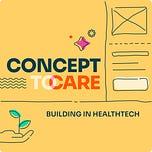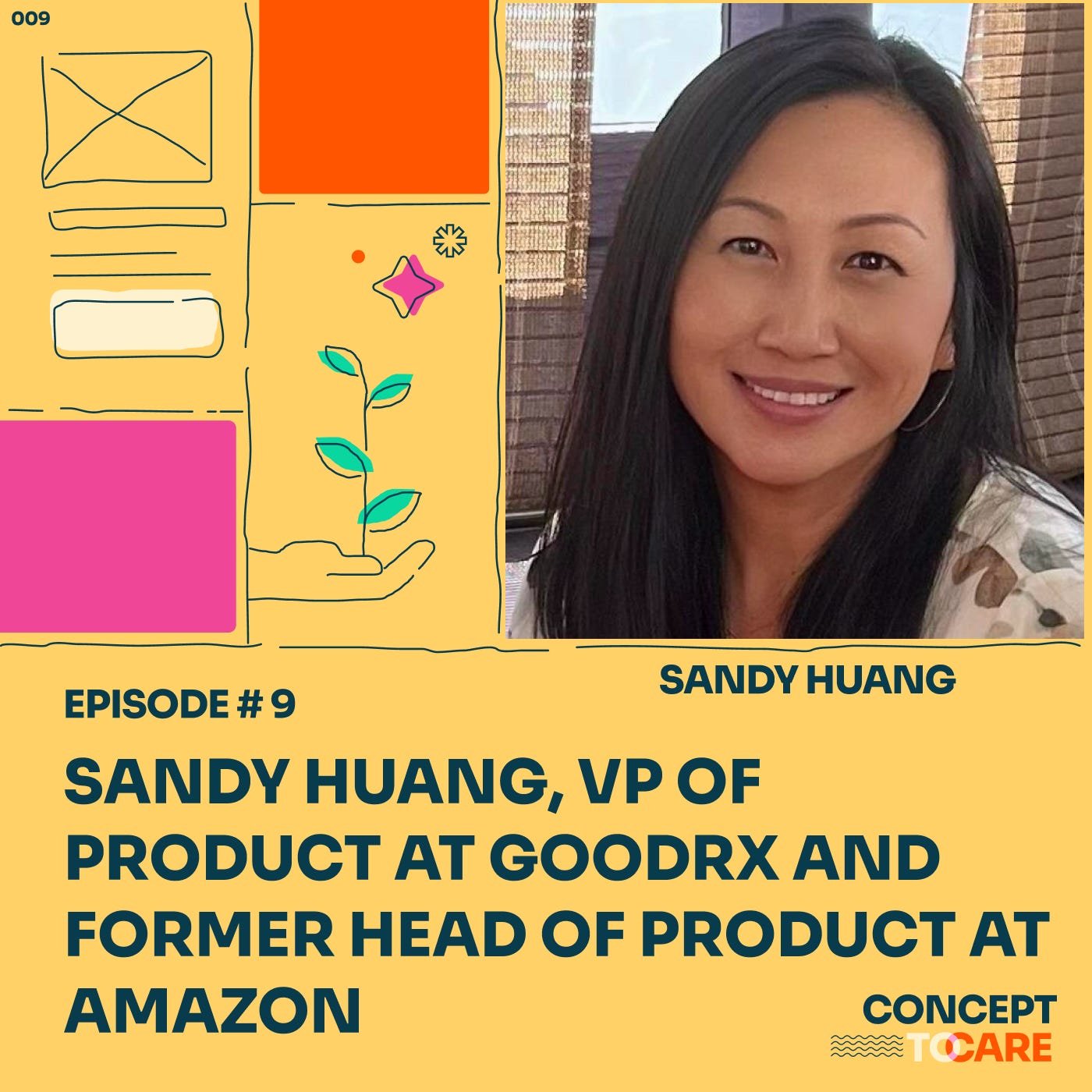On the latest episode of Concept to Care, Sandy Huang, a seasoned consumer tech product executive, shares insights on joining a health tech company like GoodRx and the skills and insights she brings from her customer-focused product management background. She discusses the challenges of setting the right user experience bar in health tech and the elements of an effective product strategy. Sandy also shares her experiences in identifying target markets, understanding customer needs, and conducting market research. Sandy Huang shares insights on product strategy, execution, and healthcare innovation. She emphasizes the importance of customer obsession, continuous research, and the balance between science and art in product management. Additionally, she highlights the significance of understanding user needs and leveraging core competencies in building product strategies.
Some takeaways
Leverage Diverse Experience: Draw from diverse industry experiences to solve problems in new ways. Sandy's background in e-commerce, communities, and collaboration software helped her bring fresh perspectives to HealthTech.
If you’re in HealthTech, consider hiring talent from various industries to bring in new ideas and methodologies.
Focus on Essential User Needs: In healthcare, the user experience bar can differ because it is a must-have. However, raising this bar is crucial to stand out. Sandy highlights the importance of reducing friction, saving costs, and improving overall user experience to make healthcare products more appealing and effective.
Regularly conduct usability tests to identify and eliminate friction points in your product.
Aim for continuous improvement by incorporating user feedback into the development process.
Conduct Cost Benefit Analysis Around the Bar: Determining how much to invest in raising the user experience bar involves evaluating the cost and benefits of each improvement. Sandy emphasizes that it’s crucial to assess whether achieving 100% in one area justifies the resources or if 80% suffices, allowing you to allocate resources to other areas.
Conduct a cost-benefit analysis to evaluate the impact of potential improvements. Determine the optimal level of investment by balancing the benefits of enhanced user experience against the associated costs. Prioritize investments that provide the highest return in user satisfaction and retention.
What Product Strategy Means to Sandy: An effective product strategy includes a clear vision, measurable goals, understanding customers and the market, leveraging company strengths, and a detailed execution plan.
Vision: Create a North Star vision for your product.
Goals: Set clear, measurable goals (both quantitative and qualitative).
Market Research: Understand your customers and market thoroughly.
Strengths: Identify and leverage your company’s core competencies.
Plan: Develop a detailed roadmap with prioritization, timelines, and milestones.
Avoid Bad Strategies: Sandy highlighted key pitfalls to avoid in product strategy. A bad strategy often includes solutions in search of problems, where a technical solution is developed without a clear understanding of the user need it addresses. Other examples include tackling problems that aren't significant or setting the wrong goals, which can misalign efforts and drive unintended behaviors.
To ensure your strategy is sound, start by deeply understanding the user problem, ensure it’s a significant issue, and set clear, aligned goals that drive the right outcomes.
Balance the North Star Metric with Supporting Metrics: Sandy emphasizes the importance of having a clear North Star metric to guide your product’s direction, but it should not be used in isolation. While the North Star provides a singular focus, it’s crucial to have supporting metrics that offer a comprehensive view of your product’s performance and ensure balanced decision-making.
Define a North Star metric that captures the primary goal of your product, such as user engagement or retention. Complement this with guardrail metrics to monitor other important aspects, like customer satisfaction, revenue, or feature usage, to prevent any unintended consequences from focusing solely on the North Star.
Consider how metrics can be “gamed”. Sandy suggests thinking about how a metric might be gamed to identify potential weaknesses and ensure balanced measurement. When setting your metrics, consider how they might be manipulated. This helps identify where additional supporting metrics are needed to create checks and balances, ensuring that your team’s actions align with the overall goals and do not lead to unintended behaviors.
Communicate Strategy Effectively Use structured documents like Amazon’s six-pagers to communicate product strategy. Sandy adapted this approach for GoodRx to ensure alignment.
Develop a concise, structured document that outlines your product strategy, vision, goals, and anticipated challenges. Use this document to align your team and stakeholders.
Right size the process for communicating strategy and getting alignment based on the stage of the company and maturity of the product. The six-pager is likely heavy for a start-up
Addressing Disagreement around Product Strategy: Sandy addressed internal disagreements about focusing on a mobile-only product by positioning it as a pilot project and demonstrating its potential with early results. She emphasized speed and delivered a beta launch in three to four months, which helped gain early buy-in from key stakeholders. For those who are looking to communicate similarly controversial strategies:
Position new, potentially controversial projects as pilots to mitigate resistance. Work quickly to deliver early results, using initial successes to build broader support and alignment within the organization.
Navigating Matrixed Organizations in Healthcare In a matrixed organization, where multiple stakeholders such as clinical owners and product teams need to collaborate, Sandy stresses the importance of aligning on the desired outcomes first. By focusing on shared goals and outcomes, and having open debates to balance different perspectives, you can set effective KPIs and drive forward. Ensure alignment on the overall vision and outcomes. Facilitate open discussions to balance various perspectives and agree on KPIs that reflect both business and product needs. Use these KPIs to create a cohesive roadmap that supports the collective goals of the organization.
Identifying Target Markets and Understanding Customer Needs: Sandy emphasizes the importance of tailoring market research methods to the stage of your product and your available resources. She highlights various approaches, from cost-effective to more comprehensive strategies, to identify target markets and understand customer needs.
Free or Low-Cost Methods:
Guerrilla Usability Testing: Conduct usability tests in public places, such as cafes, where you can interact with potential users and gather feedback.
Surveys: Use free or low-cost online survey tools to collect data on user needs and preferences.
Interviews: Conduct phone or in-person interviews with potential users to gain qualitative insights.
Moderate-Cost Methods:
Focus Groups: Organize focus groups where you can engage with users in a controlled environment to understand their needs and pain points.
Usability Testing: Offer small incentives, such as gift cards, to participants who provide feedback on your product.
Higher-Cost Methods:
In-Home Studies: Conduct in-home studies to observe users in their natural environment and gather in-depth insights into their behaviors and needs.
Professional Services: Invest in professional market research services to obtain data.
Tailor your market research approach based on your budget and the stage of your product. Use a mix of qualitative and quantitative methods to gather comprehensive insights into your target market and customer needs.
Refreshing Product and Market Research Sandy emphasizes the importance of periodically refreshing product and market research to ensure that the insights remain relevant and accurate. This is particularly crucial in fast-changing industries like healthcare and technology. Schedule regular reviews of your market research and product strategy. Continuously gather new data and feedback to stay updated on market trends and evolving customer needs. This approach helps ensure that your product remains aligned with current market conditions and user expectations, allowing for timely adjustments and improvements.
Executing the Product Strategy: Sandy provides actionable insights on how to effectively execute a product strategy, emphasizing the importance of a structured approach and continuous alignment with the core vision and goals.
Build from the Core Outwards:
Focus on the core needs of users first. Ensure the foundational aspects of your product are solid before adding additional features.
Example: For Amazon Visual Shopping, Sandy focused on improving the quality of the image search results before introducing additional features.
Leverage Existing Ecosystems:
Integrate your product with existing ecosystems to enhance its value and usability.
Example: Sandy integrated Amazon’s visual shopping feature with the broader Amazon ecosystem through features like "More Like This" and "Find on Amazon," making it more accessible to users.
Pilot Projects and Early Wins:
Position new initiatives as pilot projects to mitigate resistance and quickly demonstrate value.
Work quickly to deliver early results and use initial successes to build broader support within the organization.
Prioritize and Sequence:
Use a prioritization framework to evaluate features on potential impact, alignment with the product strategy, and level of effort.
Develop a detailed roadmap with clear prioritization, timelines, and milestones to ensure strategic execution.
Continuous Monitoring and Adaptation:
Include success metrics in your initial requirements and iterate based on the results.
Regularly track key performance indicators (KPIs) and adjust the strategy as needed based on insights gathered.
Focus on building a strong core product, leverage existing ecosystems, and prioritize effectively. Use pilot projects to gain early wins and continuously monitor and adapt your strategy based on performance metrics and market feedback.
—
Where to find Sandy Huang:
—
Where to find Angela and Omar:
Angela Suthrave
Omar Mousa
—
Referenced:
GoodRx: https://www.goodrx.com/
GoodRx Gold: https://www.goodrx.com/gold
Product Must-Haves versus Nice-to-Haves: https://medium.com/@vishallayog/must-haves-v-s-nice-to-haves-features-937cc1eb7178
Product Strategy: https://www.productplan.com/glossary/product-strategy/
Amazon Echo Show: https://press.aboutamazon.com/2023/9/amazon-unveils-next-generation-echo-show-8-all-new-echo-hub-and-new-echo-frames
Jive Collaboration Software: https://www.jivesoftware.com/
KPIs & Goal Setting: https://medium.com/@kaustubhkalita_31668/okr-and-kpi-striking-the-right-balance-for-goal-setting-ef8fd39dc06a
Types of user studies: https://www.userinterviews.com/ux-research-field-guide-module/user-research-methods
Amazon’s multi-modal search: https://searchengineland.com/amazon-new-search-functions-mobile-google-431967
Amazon 6-pagers: https://www.larksuite.com/en_us/blog/amazon-6-pager
How Product Discovery saves time and money: https://www.twentyideas.com/blog/how-product-discovery-saves-time-money
How GoodRx is a multi-sided marketplace: https://www.summithealth.io/insights/what-could-a-healthcare-marketplace-look-like-goodrx-is-trying-to-show-us
Product Dogfooding in software development: https://userpilot.com/blog/product-dogfooding/
Women + digital health: https://rockhealth.com/insights/building-comprehensive-women-digital-health-eight-sectors-serving-women-needs/
—
Check out our website: https://www.concepttocare.com
Follow us and Subscribe wherever you get your podcast:
















Share this post